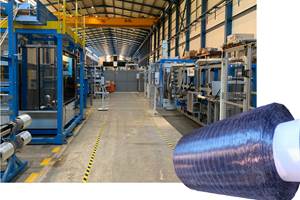If we recycle it, will they come?
Thanks to the 787 and the A350 XWB aircraft programs, the composites industry has more scrap carbon fiber prepreg than it knows what to do with. At least, not yet.

Thanks to the 787 and the A350 XWB aircraft programs, the composites industry has more scrap carbon fiber prepreg than it knows what to do with. At least, not yet.
The Institute for Advanced Composites Manufacturing Innovation (IACMI, Knoxville, TN, US), the public/private consortium created to accelerate the evolution of composites technologies in automotive, wind, pressure vessels, design engineering and manufacturing processes, is six months old and in January hosted its second membership meeting in Detroit, MI, US, to coincide with the North American International Auto Show (NAIAS).
The meeting — a “where are we now” update on the consortium’s progress — gathered 290 members, representing every stratum of the composites industry, including suppliers, OEMs, academicians and government officials.
In terms of size (US$259 million in public and private funds), scope and ambition, IACMI is a first-of-its-kind organization for the American composites industry, and it has set some decidedly ambitious goals, ranging from dramatically reducing the cost of carbon fiber manufacture to development of automated, high-speed manufacturing processes for wind energy and automotive applications.
It is, thus, understandable that some members — despite already having invested in the consortium — exhibited skepticism about its viability. Indeed, during breaks at the Detroit meeting, it was not uncommon to be asked, “So, what do you think? Does this thing have a chance?”
If the first six months of progress represent what is to come, I, for one, am optimistic. There are, at IACMI’s helm, people passionate and knowledgeable about composites manufacturing, and clearly dedicated to seeing the consortium sustain itself beyond the initial five-year funding window. Already, IACMI is investing in substantial development work that proves this is not a government-sponsored boondoggle (for a full report on the meeting, visit short.compositesworld.com/IACMI16).
Most of IACMI’s goals, although ambitious, strike me as realistic and, if achieved, could move the composites industry forward substantially in terms of efficiency, manufacturing quality and cost. There is one goal, however, that, to be met, will require not just money and effort and creativity, but the creation of an entirely new end-market. By 2020, 80% of all glass and carbon fiber composite parts must be recyclable, and by 2025, >95% of those parts must be recyclable.
We have the technology, today, to recycle cured and uncured composite materials of many types. In this sense, nearly every composite part is already “recyclable,” and could be recycled with an investment in the capital and equipment required for the task. But it’s one thing to assume that the part eventually will be recyclable, but quite another to presume that it, in fact, will be recycled and reused in one of a host of applications designed to consume used or non-virgin fiber. And that’s the rub. There is, today, no “host of applications” waiting for the wave of recycled fiber that will, if IACMI succeeds, flood the market.
Creating that host of applications will be no trivial undertaking. Recycled fiber must first be tested and characterized. Is it glass or carbon? Is it chopped? If so, how long are the fibers? What are the strength and stiffness properties? These properties then must be matched up with potential applications. Further, given the volume of used material that conceivably could be made available, it will probably be necessary for some large OEMs — Boeing, Airbus, Ford, Toyota, etc. — to step up and commit to an effort to find a use for recycled fibers, like BMW has done with its i3 roof.
One step in the right direction can be found this month in "Recycled carbon fiber proves its potential for aircraft interiors," a story written by senior editor Ginger Gardiner about use of recycled carbon fiber by Airbus in an aircraft interiors R&D program (read more by clicking on its title under "Editor's Picks" at top right). A successful recycling industry, however, will require thousands of efforts like this one. And soon.
The bottom line is this: The composites industry’s expansion is creating a waste stream for which we all must take responsibility. I hope that IACMI’s edict will provide the spark we need.
Related Content
Update: THOR project for industrialized, recyclable thermoplastic composite tanks for hydrogen storage
A look into the tape/liner materials, LATW/recycling processes, design software and new equipment toward commercialization of Type 4.5 tanks.
Read MoreNovel dry tape for liquid molded composites
MTorres seeks to enable next-gen aircraft and open new markets for composites with low-cost, high-permeability tapes and versatile, high-speed production lines.
Read MoreDrag-based wind turbine design for higher energy capture
Claiming significantly higher power generation capacity than traditional blades, Xenecore aims to scale up its current monocoque, fan-shaped wind blades, made via compression molded carbon fiber/epoxy with I-beam ribs and microsphere structural foam.
Read MoreHonda begins production of 2025 CR-V e:FCEV with Type 4 hydrogen tanks in U.S.
Model includes new technologies produced at Performance Manufacturing Center (PMC) in Marysville, Ohio, which is part of Honda hydrogen business strategy that includes Class 8 trucks.
Read MoreRead Next
VIDEO: High-rate composites production for aerospace
Westlake Epoxy’s process on display at CAMX 2024 reduces cycle time from hours to just 15 minutes.
Read MoreModeling and characterization of crushable composite structures
How the predictive tool “CZone” is applied to simulate the axial crushing response of composites, providing valuable insights into their use for motorsport applications.
Read More“Structured air” TPS safeguards composite structures
Powered by an 85% air/15% pure polyimide aerogel, Blueshift’s novel material system protects structures during transient thermal events from -200°C to beyond 2400°C for rockets, battery boxes and more.
Read More






















